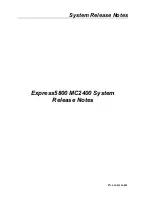
2-1
2: Concepts
2.1 Services
Services are the basic method of connecting to the Server from any host or another server. In general, a
service is required on the Server before any job or connection queueing will take place. See the Server
Configuration chapter for details on creating and using services.
2.2 Network Protocols
A network protocol describes the data contained in Ethernet packets. The network protocols provided by the
Server are completely separate, other than the use of the Ethernet data layer. The following figure shows the
protocol stacks supported by the Server.
Figure 2-1: Supported Network Protocols
There are three different Ethernet frame formats, one of which is subdivided:
◆
What is typically called Ethernet is technically referred to as Ethernet v2. This is the default frame
type for most TCP/IP, LAT, and MOP/NCP protocol stacks. It can also be used for NetWare.
◆
The IEEE 802.2 frame format comes with either a regular or a SNAP SAP (Service Access Point).
AppleTalk uses the SNAP format by default. Both types can be used by NetWare.
◆
NetWare 2.x and 3.x stations, by default, do not use any of these frame types. They use a native mode
format that is being phased out.
2.3 AppleTalk
AppleTalk is a protocol used primarily by Apple Macintoshes to access network resources such as file
servers and printers. AppleTalk is also available for UNIX, NetWare, and other operating systems. The
AppleTalk protocol can be run over Ethernet (EtherTalk), Token Ring (TokenTalk), or LocalTalk, which is
a medium speed network type built into every Macintosh. These various network media can be connected
with AppleTalk routers to allow all nodes to communicate with one another. The AppleTalk protocol
supports features such as file sharing and security in addition to printing.
AppleTalk
LAN Manager
LAT
NetWare
TCP/IP
Printer
Access Pro-
tocol
SMB
LAT
NCP
Telnet/ Rlo-
gin/ RTEL/
lpd
ATP
NetBEUI
SPX
TCP
DDP
IPX
IP
Ethernet/IEEE 802.3 Data Layer















































